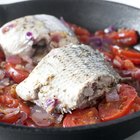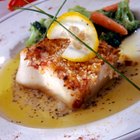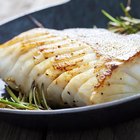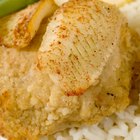HandmadePictures/iStock/GettyImages
Tilapia is sometimes called aquatic chicken because of its neutral flavor. It has almost no fishy taste so even picky eaters may like it. You can grill it, saute it, bake it or fry it. Breading tilapia gives it a flavorful, crunchy crust. Rice flour, which is available in most grocery stores or natural food stores, is a gluten-free alternative to other types of breadings, including wheat flour and bread crumbs.
About Rice Flour
If you're looking for a gluten-free alternative to wheat-based breading, rice flour is a smart option. Rice flour -- even rice flour made from short-grain glutinous rice, or sticky rice -- is always gluten-free. Sweet rice flour, which is made from sticky rice, is most often used as a thickener in sauces and desserts, while regular rice flour is preferred for baking and breading. Rice flour adds a mild, slightly sweet flavor to breaded tilapia.
How to Bread Tilapia
To bread tilapia with rice flour, combine the rice flour with any desired seasonings. Dip the tilapia in milk or beaten egg, or simply run it under water so the breading sticks to it. Dip it in cornstarch or arrowroot first, if you like, which thickens the breading and creates a crispy coating. Then dip the fish in the seasoned rice flour. Fry the fish in hot oil for five to seven minutes until the coating is golden brown and the fish is firm, white and opaque.
Accompaniments and Sauces
Tilapia breaded with rice flour has such a neutral taste that you can use it with almost any seasoning. Combine the rice flour with garlic, chili powder and crushed red pepper flakes for a fiery southwestern version. Crumble the tilapia into small pieces as a filling for fish tacos. Top with tomatoes and lettuce or a coleslaw enlivened with red pepper, avocado and cilantro. Add lime, ginger and garlic to the rice flour and you have the basis for an Asian-inspired dish. Serve with brown rice and stir-fried vegetables.
Tilapia 101
Tilapia hails from Africa, but in recent years, fish farmers from more than 100 countries have begun farming it in closed indoor systems. Tilapia is the fourth most commonly eaten seafood in the U.S. after shrimp, salmon and tuna. Currently, only 5 percent of the tilapia consumed here was actually raised here. Most tilapia is imported from Southeast Asia or South America. However, it's worth it to seek out tilapia raised close to home. Tilapia raised in Canada, Equador and the U.S. get the highest marks because they're generally raised using clean, sustainable methods, according to the Monterey Bay Aquarium. Whether you bread tilapia with rice flour, steam it or use another method to cook it, keep in mind that as an herbivorous fish, tilapia is much lower in omega-3 fatty acids than other fish. Although it's a good source of lean protein, it doesn't appear to be as heart healthy as fish high in these fatty acids, such as salmon, according to the New York Times.
Related Articles

How to Soak Tilapia in Milk and Panko ...
How to Cook a Turbot in the Oven

How to Cook Tilapia With Orange Juice & ...

How to Cook a Turbot Fillet

How to Cook Hog Fish

How to Bake Boneless Skinless Tilapia
Cooking Haddock

Frying Whiting Fish Using No Flour
How to Cook Atlantic Cod Fillets

How to Pan Sear Sea Bass

How to Cook Tarakihi

How to Cook Frozen, Boneless & Skinless ...

How Do I Pan Fry Fresh Fish With a ...

How to Cook a Cajun Seasoned Catfish ...

How to Pan Fry Tasty Perch Fillets
How to Cook Cobia

How to Pan-Sear Swordfish

How to Cook Stuffed Tilapia

How to Cook Trevally

How to Cook Mackerel in an Oven
References
Writer Bio
Julie Christensen is a food writer, caterer, and mom-chef. She's the creator of MarmaladeMom.org, dedicated to family fun and delicious food, and released a book titled "More Than Pot Roast: Fast, Fresh Slow Cooker Recipes."